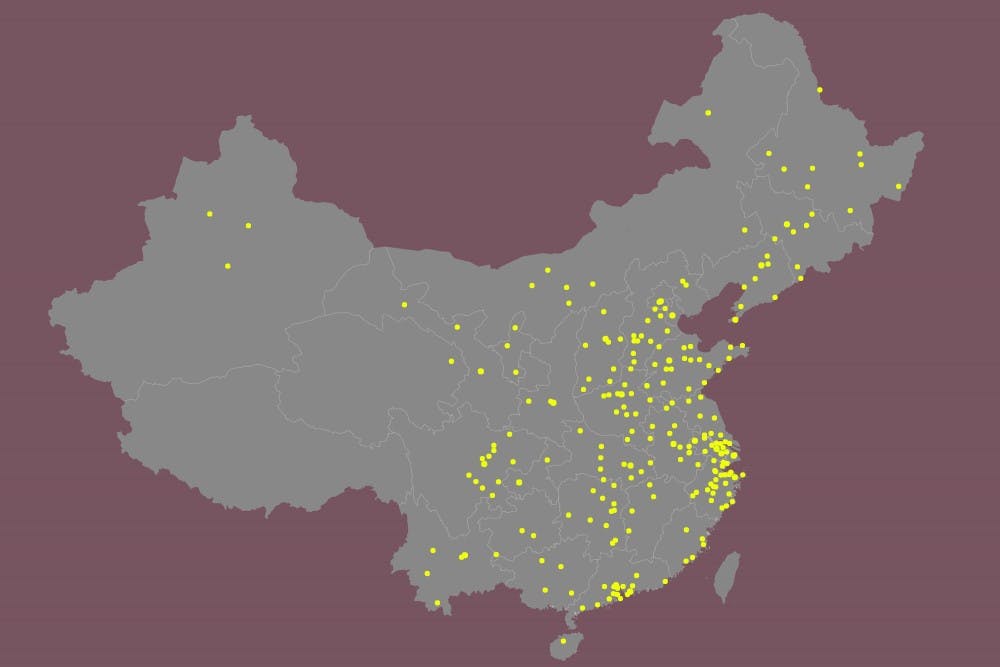[et_pb_section bb_built="1" _builder_version="3.15"][et_pb_row][et_pb_column type="4_4"][et_pb_text _builder_version="3.15"]

The most popular cities from which our Chinese international students come from the Oxford. Shanghai is home to 248.
Miami's Chinese students are just as diverse as our domestic population. Some hail from the world's largest city (and the second-largest and the fourth). Some come from cities with acres of solar panels, and some come from cities at the base of sacred Buddhist mountains. Some of our Chinese students drive expensive cars and hang out with their friends, while some prefer to study. Most are avid users of WeChat, and most are concerned about finding a job after graduation.
But all of them have one thing in common -- they're trying to navigate life on a campus, and in a country, that isn't made for them. In a Trumpian era marked by anti-multicultural rhetoric and on a campus surrounded predominantly by white students whose native language is English, Chinese students at Miami are beacons of the university's stated commitment to diversity. But those institutional diversity goals can't be met if domestic students don't view their Chinese counterparts as peers -- in the classroom and off campus.
According to the Institute of International Education, 33 percent of international students studying in the U.S. in 2018 come from China. India sends the second-highest proportion of students, at 18 percent.
The U.S.' appeal to international students is rooted in the increased freedoms, said Chen Zhao, director of Miami's Confucius Institute, in a 2016 presentation titled "Understanding Chinese Students at Miami."
"What's the goal [in coming to the U.S.]? The goal is to become -- it's a very popular word in China -- a globalized person," Zhao said.
English-language skills, Zhao explained, are crucial to landing a business job back in China. Not only is the U.S. a popular destination for picking up English, but American universities' application requirements are less stringent than those in China. Whereas standardized test scores are accompanied by students' essays and biographical information in the U.S., Chinese universities rely solely on scores from the Gaokao, the Chinese equivalent of the ACT or SAT.
At Miami, it was the Farmer School of Business that brought the first wave of Chinese students, in the early 2000s.
"The initial group of undergraduate students who came from China, they were really interested in the business school...We were doing really well in overall U.S. News rankings, especially the business school, and that really kind of got us on the map," said Aaron Bixler, the university's associate director for international recruitment.
Enjoy what you're reading?
Signup for our newsletter
A decade later, Chinese international students are still the fastest-growing population at Miami. In a city of 23,000, they account for over 10 percent of the population, making Oxford one of the most unique cities in the United States. In the past decade, Miami has added 2,000 Chinese international undergraduates to its Oxford campus body. This is double the number Miami had just four years earlier.

And it shows in Oxford, where nearly 20 Chinese restaurants have cropped up within city limits. Uptown has become a Mecca for those who are not just looking for a drink, but for a cultural expansion.
During his first visit to Miami, a Chinese student who goes by Bill was trying to find Armstrong Student Center when a man came up to him and said, "It's over there," in Mandarin.
For some international students, it may be surprising to hear their native language so far from home. To arrive at a school where thousands of people speak Chinese becomes a double-edged sword for those hoping to improve their English, and has become the primary differentiator between students from China and other international students.
Pruckno said that students don't necessarily want to go to a school with a lot of other Chinese students. This may be supported by some students' willingness to attend American high schools to immerse themselves at an early age. Nevertheless, some students state that they came to Miami because they knew someone here.
Others said they like Miami because of the international alumni network, the option to have a roommate who speaks their language, and the Uptown food scene some have called Miami's "Chinatown."
"We live in this multicultural world, and you're bringing people from different perspectives and nationalities and cultures and identities together, and I think in general the trend is we're getting better [at facilitating interactions]," said Dan Sinetar, international student coordinator for Global Initiatives. "That's part of the reason why our office exists."

Miami's allure for Chinese students has expanded beyond its rankings.
"Rankings are still pretty important to Chinese families. Safety is another big factor," Kathy Pruckno, senior associate director of admissions said, explaining the perception in China is that Midwest is a safer environment than larger cities on the coasts.
However, Pruckno acknowledges the changing political climate in the U.S. may dampen that perception.
"We're in kind of a strange situation now," Pruckno said. "You can't be safe everywhere."
Bixler and Pruckno agreed that Miami's location in the Midwest is also a concern for diversity. They said there is a fear among Chinese students that being landlocked in the U.S. leads to isolation, as opposed to studying in a larger coastal city with easier access to other cultures.
The financial path to Miami is no easier than the cultural one. Contrary to the commonly-held perception that all Chinese students come from upper-class families, many Chinese parents save for decades to finance their students' education.
The gravity of that investment, coupled with the years students spend focusing on regimented test-taking in the Chinese educational system, leads to a trust that students will not squander their parents' investment while studying abroad.
Miami does not charge international students more for tuition. The tuition and fees Chinese international undergraduates pay are roughly the same as out-of-state students', with the addition of a one-time visa processing fee and travel expenses.
The university's goal is to diversify and add to the campus community, said Pruckno.
"We think students do best in a community where they're learning from each other and having exposure to a broad range of experiences," she said. "It just so happens that Chinese students right now, the economy supports them."
Bixler said that the university's international applicant pool is predominantly Chinese.
"It's not that [Chinese students] are being admitted at a higher rate than other international students necessarily," Bixler said. "They're just a large portion of the pool right now...It kind of ebbs and flows."
But the culture among domestic students and faculty at Miami isn't configured to allow for such ebbs and flows. So what are ways our campus can grow to meet its ambitions of international diversity?
In this special section, The Miami Student is endeavoring to offer some answers.
Megan Zahneis and Rachel Berry contributed to this report.
newberaj@miamioh.edu
correction: a previous version of this story and still in print featured a map that did not include Taiwan.
[/et_pb_text][/et_pb_column][/et_pb_row][/et_pb_section]




